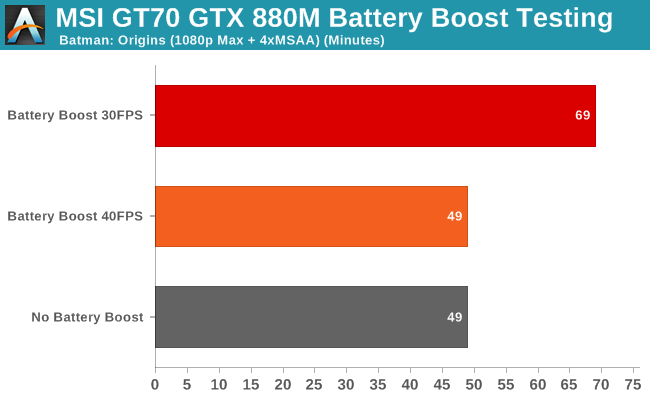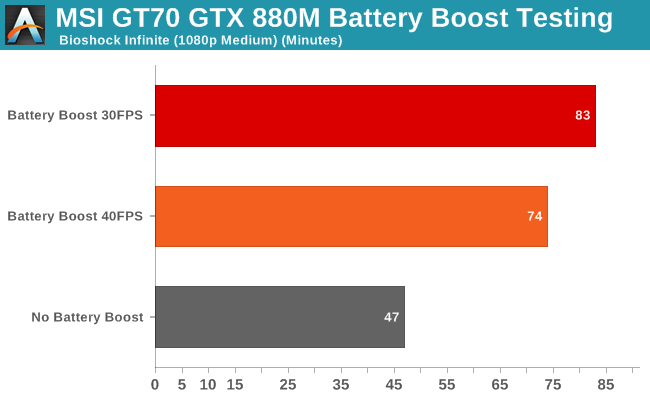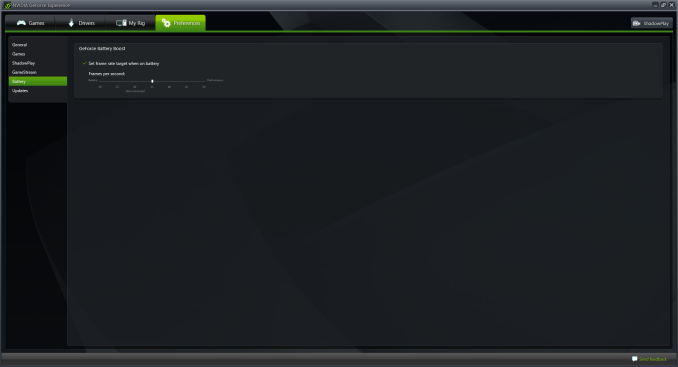MSI GT70 Review: GTX 880M Edition
by Jarred Walton on April 16, 2014 6:00 AM ESTMSI GT70 GTX 880M: Battery Boost
After the gaming potential, the next most interesting aspect of the GT70 – and the GTX 880M – is going to be NVIDIA’s new Battery Boost technology. Battery Boost is part of the GeForce Experience software package, and it’s currently only available with GTX 800M GPUs. It’s a single setting that you can either enable or disable, with a target frame rate slider ranging from 20 FPS to 50 FPS. Given this is a work in progress, you can expect changes to the feature over the coming months, but let’s just start with what we have right now.
We’ll need to spend additional time investigating the quality, performance, and battery life tradeoffs that are available, but for the time being we ran some tests with three games, choosing a specific quality setting for each and testing without Battery Boost and with Battery Boost using both 30FPS and 40FPS targets. We’ll also repeat our discussion of gaming performance on AC power as a reference point, and as you’ll see even without Battery Boost enabled, at least on the MSI GT70, there’s a rather large loss in performance that comes with the removal of AC power. The three games and settings we used are Batman: Origins at our “Enthusiast” settings (1080p, 4xMSAA, and everything else maxed out with the exception of PhysX, which is left off), Tomb Raider (1080p and “High” defaults), and Bioshock Infinite (1080p and “Medium” defaults).
There are many things we can look at with Battery Boost: average frame rates, minimum frame rates, battery life, GPU core/RAM clocks, and GPU utilization are all potentially interesting. Something else that came up during testing that’s also worth a short discussion: game/level load times. You wouldn’t think that would be much to talk about, but at least in our initial testing – and keep in mind that we’re using a notebook with pure HDD storage – we found level load times could be almost unbearable with Battery Boost set to 30FPS in some games. We’ve mentioned this to NVIDIA, and they were able to reproduce our longer load times, but the 5+ minute load times in Batman Origins were not something they could recreate; most of the other games I checked took 25-50% longer to load with Battery Boost at 30FPS compared to running off the battery without Battery Boost. This should be fixed in a future update, either to the drivers, or GeForce Experience, or both.
As for reporting the other figures, we’re going to hold off on that for a bit longer while we run additional testing. We’re working on a lengthier analysis of Battery Boost, and we’ll cover such things as minimum frame rates, average power use, etc. in a future article. For now, let’s just focus on the battery life as well as the average frame rates (though we won’t have graphs for the latter). We used the “Balanced” power profile with the display at 200 nits (70%) and timed how long it took before the system shut down. To keep things repeatable and consistent, we just loaded a save on each game and left it running, so there are no level loads (other than the initial startup of a game) or any “real” gameplay, but there is a constant load on the system during the testing.

Starting with Batman, if you focus solely on the percent increase in gaming battery life, Battery Boost looks pretty promising. In Batman: Origins, there’s a 41% increase in gaming time at the 30FPS target. Unfortunately, setting the target to 40FPS, there appears to be no change at all in battery life, likely because average frame rates even without Battery Boost are only 44FPS at the selected settings. As we’re using our Enthusiast settings, the average frame rate under AC power for our particular save is only 65FPS. Since Batman was the first game we tested (and one of the few games that clearly breaks 60FPS average at maximum quality settings on AC power), we decided to drop to slightly lower quality settings for the next two games.

Dropping the quality settings a bit, Tomb Raider at High detail shows an improvement in battery life both at the 30FPS and 40FPS targets, but not surprisingly the boost is larger with the lower frame rate. The increase in battery life is 48% at 30FPS compared to just 13% at 40FPS. Average frame rates without Battery Boost are 63.9, so despite NVIDIA’s claims to the contrary, it seems like most of the increase in battery life comes by capping the frame rate – in fact, the loss in average frame rate is greater than the increase in battery life (though obviously there are other factors at play). Frame rates on AC power for this particular scene average 88FPS.

Given that higher base frame rates appear to result in a larger improvement in battery life, for our third test we decided to drop down to medium quality in Bioshock Infinite. Here we see the largest increase in battery life of our testing: 77% additional battery life with a 30FPS target, and a still sizeable 57% increase with a 40FPS target. The non-Boost framerate is 63FPS, so again we see a very strong correlation between frame rate targeting and Battery Boost. Interestingly, however, at 40FPS we see a greater benefit compared to Tomb Raider, so at least we do have some evidence that there’s more than just frame rate targeting coming into play. AC frame rates at our test settings, incidentally, are 123FPS.
As noted, there are a lot of potential items to discuss with Battery Boost, and I’m not going to spend too much more time on the subject here. The technology does work, but the gains are going to be heavily influenced by your choice of game as well as graphics settings. My recommendation is to generally shoot for Medium to High detail at 1080p (at least on the GT70), as that still provides a decent quality level while allowing the GPU to rest a bit (i.e. average frame rates without Battery Boost will typically be north of 60FPS).
Besides the odd behavior with level/game load times taking longer with Battery Boost – sometimes substantially longer – there’s one other piece of information I need to quickly mention: minimum frame rates. With Battery Boost at 30FPS, the minimum frame rates can periodically dip well below 30FPS – sometimes even into the teens or single digits on some titles. This appears to be buggy behavior, as at 40FPS the minimum frame rates are often close to 40FPS, but right now there are at least a few games where using a 30FPS target will result in a rather poor gaming experience; targetting 35 or 40 FPS currently results in a much better experience.











61 Comments
View All Comments
Hrel - Wednesday, April 16, 2014 - link
I've always wondered why laptop GPU's include so much extra GPU RAM. I've never seen a GTX660 with 4GB of RAM, much less 8. Yet I saw GTX460M's configured with 4GB of RAM years ago. What gives?Gunbuster - Wednesday, April 16, 2014 - link
It's a check box feature. That RAM is not that expensive and makes the system sound more impressive. It's not like they can stick a huge gaudy yellow three fan MSI cooler on the prefab graphics module they buy from Nvidia...ssiu - Wednesday, April 16, 2014 - link
And I always thought the 4GB on mobile GPUs are typos, since even desktop cards like 780Ti doesn't have 4GB. So they really have 4GB (and 8GB for this one)?? *mind blown*Batmeat - Wednesday, April 16, 2014 - link
I have the GE70. The machine is amazing. IMO save yourself the money and put your own SSD in. That's what I did.emarston - Thursday, April 17, 2014 - link
Same here, I popped in 2 SSDs in my GE70 and it's awesome.Harmattan - Wednesday, April 16, 2014 - link
Let's call this like it is... this is a 3 year-old laptop using a 1 1/2 year-old GPU. The 880m is the same exact chip as last year's 780m (which provides the same or better performance when overclocked) -- it's as if, in the desktop space, NVDA was to increase the GTX 780's core speed a bit and call it a "GTX 880". Further, the 880m is same chip as a 680m albeit with another shader block enabled. My issue is not the performance the 880m/780m provides, which is very good -- it's the fact that NVDA is sitting on tech and dribbling it out -- with virtually no cost improvement -- since there is no competition whatsoever at the high end. We need a high-end Maxwell mobile solution toute suite.Also, just a note on the pricing points you make at several points: this GT70 as configured is actually $50-100 more expensive than an NP8278/P170SM (which actually had some cosmetic changes since the last version, and has much better cooling) with the same hardware depending on the reseller -- not sure where you're pricing these machines...
Meaker10 - Wednesday, April 16, 2014 - link
Still has a much worse speaker setup and keyboard however.godlyatheist - Wednesday, April 16, 2014 - link
Where can you buy the i7-4700MQ 3 years ago? Oh wait, you can't.It's not a crime to use existing design and update them. They are faster (even if marginally) and not more expensive compared to the release price of the old gen equivalent. I don't get the problem here. It's not like they marketed the 680M laptop for $1000 and 880M ones for $2000.
"The 780m (which provides the same or better performance when overclocked)" That statement says the 880m improved because it is able to reach higher clock at same power envelope. You may think it's nothing, but you can't deny it's an improvement.
You said it yourself, there is no competition at the high end. Is it Nvidia's fault that AMD can't compete? Why should they do anything when refreshing existing design let's them reign with ease?
MSI has traditionally been weak in the cooling department, because they make budget gaming laptops. They are going to save the $$$ somewhere and cooling is what MSI chose. If you only care about specs, sure go with Sager/Clevo. All the other stuff surely aren't worth $50-100 right?
I have the P150HM/NP8150 with 2nd gen i7 + 680M and it runs any game I need comfortably. It has a dual fan design yet the cooling is crap unless you mod the casing. The reason is thin heatpipe and lack of air intake. Clevo has improved since then but it's the same as any other company. Oh yea, the keyboard is junk on it.
danwat1234 - Tuesday, April 22, 2014 - link
The MSI has a very high flow 12V cooling fan. If you crank the fan to full speed, temps will stay nice even at full load on all processors. Unless it's needs a repaste.pmpysz - Wednesday, April 16, 2014 - link
"ASUS is now using an IPS panel in their competing G750 series"What model? I've been looking at them all and haven't seen a single IPS panel in any of the G750s. Even the new ones with the 800 series GPUs.